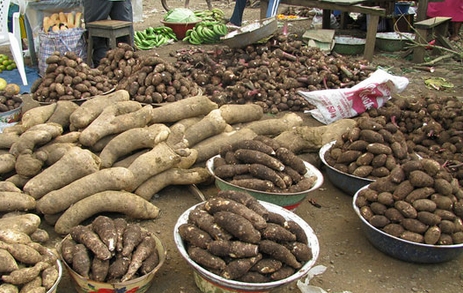
support@yorubalibrary.com
+2348073529208, 07038599574

Yam holds a special place in Yoruba cuisine, often considered the cornerstone of many traditional dishes. This staple food is not only nutritious but also versatile, lending itself to a variety of preparations that showcase the rich culinary heritage of the Yoruba people.
The Cultural Significance of Yam
Yam is deeply embedded in Yoruba culture, symbolizing prosperity and celebration. The New Yam Festival, celebrated annually, marks the beginning of the yam harvest and is a time of thanksgiving and feasting. This festival underscores the importance of yam in both the diet and the cultural practices of the Yoruba.
Common Yam Varieties
There are several varieties of yam commonly used in Yoruba cooking, each with its unique taste and texture. These include:
• White Yam (Dioscorea rotundata): This is known as "Isuko" or "Ako Isu" in Yoruba Language. It is most common variety, known for its starchy texture.
• Water Yam (Dioscorea alata): Yoruba called this type of yam "Ewura", It is softer and more mucilaginous, often used in specific dishes.
• Yellow Yam (Dioscorea cayenensis): It is known as "Igangan" in Yoruba language, it is slightly sweet and yellow-fleshed, preferred for certain recipes.
• Three-Leaf Yam (Dioscorea spp): It is called "Esuru" in Yoruba language, it comes in two different forms - yellow and white, it is sweet/salty in taste and preferred for certain recipes.
Popular Yam-Based Dishes
1. Pounded Yam (Iyan): Perhaps the most iconic yam dish, pounded yam is made by boiling yam and pounding it until it becomes smooth and stretchy. It is typically served with various soups such as egusi or efo riro
2. Yam Porridge (Asaro): This comforting dish involves yam chunks cooked with tomatoes, peppers, onions, and palm oil until tender. The resulting porridge is thick and flavorful, often garnished with vegetables and fish or meat.
3. Fried Yam (Dundun): Fried yam slices are a popular street food, often enjoyed with spicy pepper sauce (ata dindin) or egg sauce. The crispy exterior and soft interior make it a beloved snack or side dish.
4. Yam and Egg Sauce: A simple yet delicious combination, boiled yam is served with a savory egg sauce made with tomatoes, onions, and peppers. This dish is a common breakfast item, providing a hearty start to the day.
5. Ikokore: A unique dish from the Ijebu people, ikokore is made from grated water yam cooked with fish, meat, and vegetables. It has a distinct texture and rich flavor, making it a special delicacy.
Nutritional Benefits of Yam
Yam is not only delicious but also packed with nutrients. It is a good source of carbohydrates, providing energy and dietary fiber. Yam also contains essential vitamins and minerals, including vitamin C, vitamin B6, potassium, and manganese, which contribute to overall health and well-being.
Cooking Techniques
Traditional yam dishes often involve specific cooking techniques that enhance their flavors and textures. These include:
• Boiling: The most common method, used for dishes like pounded yam and yam and egg sauce.
• Frying: Used for making dundun, giving the yam a crispy exterior.
• Stewing: As in the preparation of asaro, where yam is cooked slowly with other ingredients to absorb their flavors.
Contemporary Yam Dishes
Modern Yoruba chefs and home cooks continue to innovate, creating new yam-based recipes that blend traditional and contemporary elements. These dishes not only honor the rich culinary traditions of the Yoruba but also cater to evolving tastes and dietary preferences.
Conclusion
Yam-based dishes are a testament to the ingenuity and resourcefulness of Yoruba cuisine. From pounded yam to yam porridge, these dishes celebrate the versatility and cultural significance of yam, making it a cherished staple in Yoruba households.

Learn about the Yoruba concept of Ìwà Pẹ̀lẹ́ (good…

Learn special praises for Divine Being and Creator…